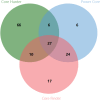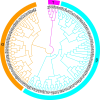Genetic relationship analysis and core collection construction of Eucalyptus grandis from Dongmen improved variety base: the largest eucalypt germplasm resource in China
- PMID: 39716061
- PMCID: PMC11667856
- DOI: 10.1186/s12870-024-05970-0
Genetic relationship analysis and core collection construction of Eucalyptus grandis from Dongmen improved variety base: the largest eucalypt germplasm resource in China
Abstract
Background: Eucalyptus grandis, which was first comprehensively and systematically introduced to China in the 1980s, is one of the most important fast-growing tree species in the forestry industry. However, to date, no core collection has been selected from the germplasm resources of E. grandis based on growth and genetic relationship analysis.
Results: In the present study, 545 individuals of E. grandis collected from 28 populations across 5 countries were selected for genetic diversity analysis using 16 selected SSR markers. The polymorphism information content (PIC) was employed to assess genetic diversity, yielding a mean value of 0.707. Genetic structure analysis was conducted on 492 individuals from 13 combined populations, revealing three clusters as the most suitable number. Principal coordinate analysis (PCoA) demonstrated that the populations were divided into three major clusters. Additionally, the analysis of molecular variance (AMOVA) indicated that the majority of variation occurred within populations.
Conclusions: Based on the criteria for screening the core collection, we constructed a population consisting of 158 individuals and created unique fingerprinting codes. These results provide a crucial theoretical foundation for the protection and utilization of germplasm resources of E. grandis in China, which will be helpful in the selection of genetically distant parents for future multigenerational hybridization programs.
Keywords: Eucalyptus grandis; Genetic diversity; Guangxi; Molecular fingerprint; Population structure; SSR markers.
© 2024. The Author(s).
Conflict of interest statement
Declarations. Ethics approval and consent to participate: The plant material of Eucalyptus grandis used in this research was collected from Guangxi Dongmen Forest Farm at Dongmen Town and its surrounding areas in Chongzuo City, China (22°20′20″N, 107°50′52″E), which was done with the permission of the local management department. Eucalyptus grandis has been widely cultivated over the past few decades, which is neither from the wild nor at risk of extinction. All samples collected are stored in the National Engineering Research Center of Tree Breeding and Ecological Restoration, Beijing Forestry University (Beijing, China). The experiments were performed in accordance with all relevant Chinese laws. Consent for publication: Not applicable. Competing interests: The authors declare no competing interests.
Figures





References
-
- Kang X. Research progress of forest genetics and tree breeding. J Nanjing Forestry University (Natural Sciences Edition). 2020;44:1–10. 10.3969/j.issn.1000-2006.202002033.
-
- Namkoong G, Kang HC, Brouard JS. Tree breeding: principles and strategies. New York, NY, USA: Springer Verlag; 1988.
-
- Bouffier L, Klapste J, Suontama M, Dungey HS, Mullin TJ. Evaluation of forest tree breeding strategies based on partial pedigree reconstruction through simulations: Pinus pinaster and Eucalyptus nitens as case-studies. Can J For Res. 2019;49:1504–15. 10.1139/cjfr-2019-0145.
-
- Kang X. Thoughts on tree breeding strategies. Journal of Beijing Forestry University. 2019;41:15–22. 10.12171/j.1000-1522.20190412.
-
- Talbert JT. An advanced-generation breeding plan for the N.C. State University-Industry pine tree improvement cooperative. Silvae Genetica. 1979;28:72–75.
MeSH terms
Grants and funding
LinkOut - more resources
Full Text Sources

